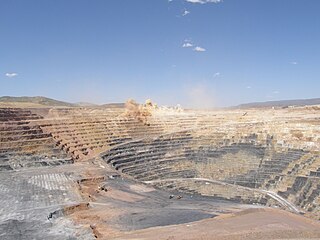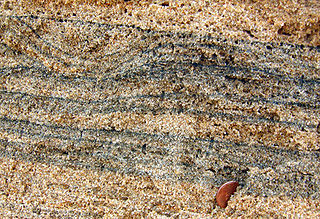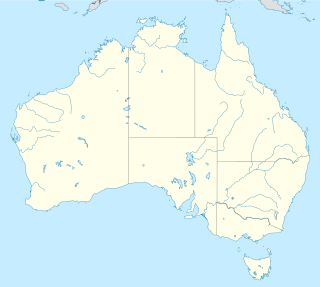
Iron ores are rocks and minerals from which metallic iron can be economically extracted. The ores are usually rich in iron oxides and vary in colour from dark grey, bright yellow, or deep purple to rusty red. The iron is usually found in the form of magnetite (Fe
3O
4, 72.4% Fe), hematite (Fe
2O
3, 69.9% Fe), goethite (FeO(OH), 62.9% Fe), limonite (FeO(OH)·n(H2O), 55% Fe) or siderite (FeCO3, 48.2% Fe).

Open-pit, open-cast or open cut mining is a surface mining technique of extracting rock or minerals from the earth by their removal from an open pit or borrow.
Tailings, also called mine dumps, culm dumps, slimes, tails, refuse, leach residue, slickens, or terra-cone (terrikon), are the materials left over after the process of separating the valuable fraction from the uneconomic fraction (gangue) of an ore. Tailings are distinct from overburden, which is the waste rock or other material that overlies an ore or mineral body and is displaced during mining without being processed.

Copper extraction refers to the methods used to obtaining copper from its ores. The conversion of copper consists of a series of physical and electrochemical processes. Methods have evolved and vary with country depending on the ore source, local environmental regulations, and other factors.

Froth flotation is a process for selectively separating hydrophobic materials from hydrophilic. This is used in mineral processing, paper recycling and waste-water treatment industries. Historically this was first used in the mining industry, where it was one of the great enabling technologies of the 20th century. It has been described as "the single most important operation used for the recovery and upgrading of sulfide ores". The development of froth flotation has improved the recovery of valuable minerals, such as copper- and lead-bearing minerals. Along with mechanized mining, it has allowed the economic recovery of valuable metals from much lower grade ore than previously.

In the field of extractive metallurgy, mineral processing, also known as ore dressing, is the process of separating commercially valuable minerals from their ores.

Heap leaching is an industrial mining process used to extract precious metals, copper, uranium, and other compounds from ore using a series of chemical reactions that absorb specific minerals and re-separate them after their division from other earth materials. Similar to in situ mining, heap leach mining differs in that it places ore on a liner, then adds the chemicals via drip systems to the ore, whereas in situ mining lacks these liners and pulls pregnant solution up to obtain the minerals. Most mining companies favor the economic feasibility of heap leaching, considering that heap leaching is a better alternative to conventional processing methods such as such as flotation, agitation, and vat leaching.

Heavy mineral sands are a class of ore deposit which is an important source of zirconium, titanium, thorium, tungsten, rare-earth elements, the industrial minerals diamond, sapphire, garnet, and occasionally precious metals or gemstones.

Mount Isa Mines Limited ("MIM") operates the Mount Isa copper, lead, zinc and silver mines near Mount Isa, Queensland, Australia as part of the Glencore group of companies. For a brief period in 1980, MIM was Australia's largest company. It has pioneered several significant mining industry innovations, including the Isa Process copper refining technology, the Isasmelt smelting technology, and the IsaMill fine grinding technology, and it also commercialized the Jameson Cell column flotation technology.

Drakelands Mine, formerly known as Hemerdon Mine or the Hemerdon Ball or Hemerdon Bal Mine, was a tungsten and tin mine. It is located 11 km northeast of Plymouth, near Plympton, in Devon, England. It lies to the north of the villages of Sparkwell and Hemerdon and adjacent to the large china clay pits near Lee Moor. The mine was out of operation since 1944, except for the brief operation of a trial mine in the 1980s. Work started to re-open it in 2014, but it ceased activities in 2018. It hosts the fourth largest tin-tungsten deposit in the world.
The mineral industry of Russia is one of the world's leading mineral industries and accounts for a large percentage of the Commonwealth of Independent States' production of a range of mineral products, including metals, industrial minerals, and mineral fuels. In 2005, Russia ranked among the leading world producers or was a significant producer of a vast range of mineral commodities, including aluminum, arsenic, cement, copper, magnesium compounds and metals, nitrogen, palladium, silicon, nickel and vanadium.

The Batu Hijau mine is an open pit copper-gold mine operated by PT. Amman Mineral Nusa Tenggara. The mine is located 1,530 kilometres (950 mi) east of the Indonesian capital Jakarta on Sumbawa, in southern Taliwang Regency, an island in West Nusa Tenggara. The mine is the result of a ten-year exploration and construction program based on a 1999 discovery of the porphyry copper deposit. Production began in 2000.

Cortez Gold Mine is a large gold mining and processing facility in Lander and Eureka County, Nevada, United States, located approximately 75 miles (120 km) southwest of Elko. It is owned and operated by Barrick Gold and comprises the Pipeline and South Pipeline deposits and the Cortez Hills deposit. Pipeline and South Pipeline are open pit mines, while Cortez Hills is an underground and open pit mining operation. Under continuous operation, Cortez has been open longer than any gold mine in the state of Nevada. It is Barrick's and Nevada's largest gold producer.
The IsaMill is an energy-efficient mineral industry grinding mill that was jointly developed in the 1990s by Mount Isa Mines Limited and Netzsch Feinmahltechnik ("Netzsch"), a German manufacturer of bead mills. The IsaMill is primarily known for its ultrafine grinding applications in the mining industry, but is also being used as a more efficient means of coarse grinding. By the end of 2008, over 70% of the IsaMill’s installed capacity was for conventional regrinding or mainstream grinding applications, with target product sizes ranging from 25 to 60 µm.

Sensor-based sorting, is an umbrella term for all applications where particles are singularly detected by a sensor technique and rejected by an amplified mechanical, hydraulic or pneumatic process. The technique is generally applied in the three industries mining, recycling and food processing and used in the particle size range between 0.5 and 300 mm. Since sensor-based sorting is a single particle separation technology, the throughput is proportional to the average particle size and weight fed onto the machine.
Cominco Resources is a private company which is developing the US $2billion Hinda phosphate project located in The Republic of the Congo. Through its subsidiary it owns 100% of the Hinda Phosphate Project, which comprises the Hinda Permit, and the Kolatchikanou Permit. The Hinda project is the world's largest undeveloped phosphate deposit with a JORC Mineral Resource of 678 Mt and a Minable Ore Reserve of 405 Mt, sufficient for over 24 years of production. Cominco Resources was merged with Kropz in December 2018 and listed on the AIM market.
Mining in North Korea is important to the country's economy. North Korea is naturally abundant in metals such as magnesite, zinc, tungsten, and iron; with magnesite resources of 6 billion tonnes, particularly in the Hamgyeong-do and Jagang-do provinces. However, often these cannot be mined due to the acute shortage of electricity in the country, as well as the lack of proper tools to mine these materials and an antiquated industrial base. Coal, iron ore, limestone, and magnesite deposits are larger than other mineral commodities. Mining joint ventures with other countries include China, Canada, Egypt, and South Korea.

The Jameson Cell is a high-intensity froth flotation cell that was invented by Laureate Professor Graeme Jameson of the University of Newcastle (Australia) and developed in conjunction with Mount Isa Mines Limited.
High frequency vibrating screens are the most important screening machines primarily utilised in the mineral processing industry. They are used to separate feeds containing solid and crushed ores down to approximately 200μm in size, and are applicable to both perfectly wetted and dried feed. The frequency of the screen is mainly controlled by an electromagnetic vibrator which is mounted above and directly connected to the screening surface. Its high frequency characteristics differentiates it from a normal vibrating screen. The high frequency vibrating screens usually operates at an inclined angle, traditionally varying between 0 and 25 degrees and can go up to a maximum of 45 degrees. Besides, it should operate at a low stroke and has a frequency ranging from 1500 - 7200 RPM.























